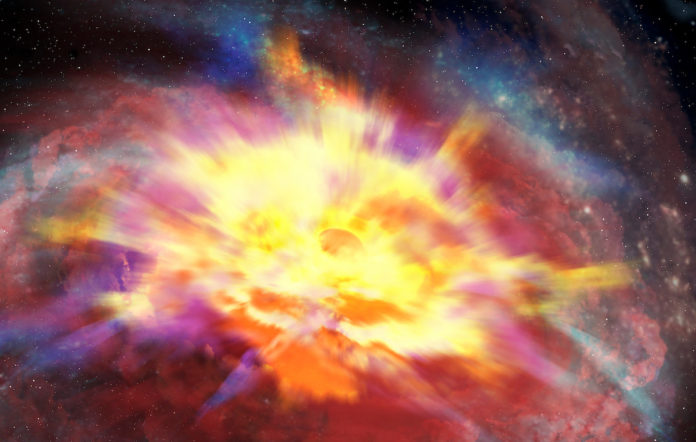Where can we find the most energetic outflows in the entire Universe? According to new research from the University of Oklahoma and Western University, the answer may be blowing in a distant galaxy’s high-speed wind.
The study revealed record-shattering wind speeds from a quasar located 10 billion light-years from the Earth, and was published in The Astrophysical Journal.
Record-breaking winds in the distant Universe
Quasars, or “quasi-stellar objects”, are some of the brightest and most energetic objects in the entire Universe. They are enormously powerful jet-like features emanating from supermassive black holes that are feeding on the gas and dust from their surrounding galaxies. These jets, and the accretion disks of gas and dust around them, are so bright that they outshine the galaxies hosting them, with the most powerful quasars reaching luminosities more than a thousand times brighter than the entire Milky Way Galaxy.
Today, astronomers believe that most galaxies—including our very own Milky Way—hosted a quasar sometime in the past.
High-speed winds are generated in quasars when superheated material is thrown out from the disk of gas and dust feeding the black hole. Such high-speed winds have been observed in quasars before, but these winds don’t typically carry large amounts of mass along in their wake. For one particular quasar known as SDSS J135246.37+423923.5, however, the story is a little different.
“The outflow from this quasar […] sweeps along a tremendous amount of mass at incredible speeds,” explained Sarah Gallagher, associate professor of physics and astronomy at Western University and observation lead for the project. “This wind is crazy powerful, and we don’t know how the quasar can launch something so substantial.”
The wind speeds measured by Gallagher and her collaborators were up to 13% the speed of light, shattering previous records for the fastest winds measured in other quasars. The researchers also determined that the supermassive black hole powering these energetic winds is 8.6 billion times more massive than our Sun, and about 2,000 times more massive than the black hole located at the centre of the Milky Way.
Hiding in plain sight — in visible light
Although this study marks the first time such energetic winds had been recorded from a distant quasar, the particular quasar observed by Gallagher and her colleagues had actually been discovered 15 years prior. The reason why these super-powered winds had been hidden so long was that they were particularly thick and dusty, which blocked most of the quasar’s visible light from being detected.
“We were shocked,” said Karen Leighly, a professor at the University of Oklahoma and one of the scientific leads for the project. “This isn’t a new quasar, but no one knew how amazing it was until the team got the [data]. These objects were too hard to study before our team developed our methodology and had the data we needed.”
Rather than observing at visible wavelengths of light, which were blocked by the thick winds from the quasar, the team used an instrument located at the Gemini North telescope that recorded infrared light. Infrared light can pass through dust more easily than visible light, which meant that the thick, dusty winds didn’t have as much of an impact on this newer data.
These longer infrared wavelengths, combined with an innovative computer modelling approach developed by the team, allowed the energetic quasar located within these thick winds to shine through.
Now, the team believes that more of these extremely windy quasars may exist throughout the Universe, previously hidden in visible light observations. By combining their new methodology with infrared observations, they hope to unveil more of these objects in the future.
“We don’t know how many more of these extraordinary objects are in our quasar catalogs that we just don’t know about yet,” said Hyunseop (Joseph) Choi, a graduate student at the University of Oklahoma and lead author of the paper. “There could be more of these quasars with tremendously powerful outflows hidden away in our surveys.”









































